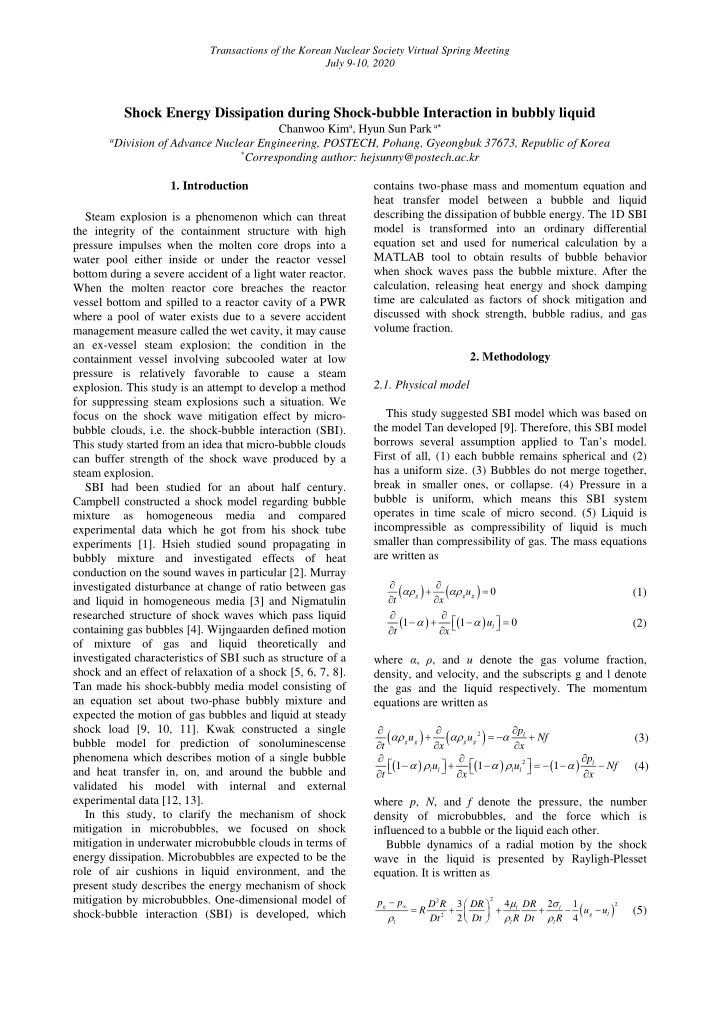

Transactions of the Korean Nuclear Society Virtual Spring Meeting July 9-10, 2020 Shock Energy Dissipation during Shock-bubble Interaction in bubbly liquid Chanwoo Kim a , Hyun Sun Park a ∗ a Division of Advance Nuclear Engineering, POSTECH, Pohang, Gyeongbuk 37673, Republic of Korea * Corresponding author: hejsunny@postech.ac.kr 1. Introduction contains two-phase mass and momentum equation and heat transfer model between a bubble and liquid describing the dissipation of bubble energy. The 1D SBI Steam explosion is a phenomenon which can threat model is transformed into an ordinary differential the integrity of the containment structure with high equation set and used for numerical calculation by a pressure impulses when the molten core drops into a MATLAB tool to obtain results of bubble behavior water pool either inside or under the reactor vessel when shock waves pass the bubble mixture. After the bottom during a severe accident of a light water reactor. calculation, releasing heat energy and shock damping When the molten reactor core breaches the reactor time are calculated as factors of shock mitigation and vessel bottom and spilled to a reactor cavity of a PWR discussed with shock strength, bubble radius, and gas where a pool of water exists due to a severe accident volume fraction. management measure called the wet cavity, it may cause an ex-vessel steam explosion; the condition in the 2. Methodology containment vessel involving subcooled water at low pressure is relatively favorable to cause a steam 2.1. Physical model explosion. This study is an attempt to develop a method for suppressing steam explosions such a situation. We This study suggested SBI model which was based on focus on the shock wave mitigation effect by micro- the model Tan developed [9]. Therefore, this SBI model bubble clouds, i.e. the shock-bubble interaction (SBI). borrows several assumption applied to Tan’s model. This study started from an idea that micro-bubble clouds First of all, (1) each bubble remains spherical and (2) can buffer strength of the shock wave produced by a has a uniform size. (3) Bubbles do not merge together, steam explosion. break in smaller ones, or collapse. (4) Pressure in a SBI had been studied for an about half century. bubble is uniform, which means this SBI system Campbell constructed a shock model regarding bubble operates in time scale of micro second. (5) Liquid is mixture as homogeneous media and compared incompressible as compressibility of liquid is much experimental data which he got from his shock tube smaller than compressibility of gas. The mass equations experiments [1]. Hsieh studied sound propagating in are written as bubbly mixture and investigated effects of heat conduction on the sound waves in particular [2]. Murray ∂ ∂ ( ) ( ) investigated disturbance at change of ratio between gas αρ + αρ = u 0 (1) ∂ ∂ g g g t x and liquid in homogeneous media [3] and Nigmatulin ∂ ∂ researched structure of shock waves which pass liquid ( ) ( ) − α + − α = 1 1 u 0 (2) ∂ ∂ containing gas bubbles [4]. Wijngaarden defined motion l t x of mixture of gas and liquid theoretically and where α , ρ , and u denote the gas volume fraction, investigated characteristics of SBI such as structure of a shock and an effect of relaxation of a shock [5, 6, 7, 8]. density, and velocity, and the subscripts g and l denote Tan made his shock-bubbly media model consisting of the gas and the liquid respectively. The momentum an equation set about two-phase bubbly mixture and equations are written as expected the motion of gas bubbles and liquid at steady ∂ ∂ α ∂ shock load [9, 10, 11]. Kwak constructed a single ( ) ( ) p αρ + αρ = − + 2 l u u Nf (3) bubble model for prediction of sonoluminescense ∂ ∂ ∂ g g g g t x x ∂ ∂ α ∂ phenomena which describes motion of a single bubble p ( ) ( ) ( ) − α ρ + − α ρ = − − − 2 l 1 u 1 u 1 Nf (4) ∂ ∂ ∂ and heat transfer in, on, and around the bubble and l l l l t x x validated his model with internal and external experimental data [12, 13]. where p , N , and f denote the pressure, the number In this study, to clarify the mechanism of shock density of microbubbles, and the force which is mitigation in microbubbles, we focused on shock influenced to a bubble or the liquid each other. mitigation in underwater microbubble clouds in terms of Bubble dynamics of a radial motion by the shock energy dissipation. Microbubbles are expected to be the wave in the liquid is presented by Rayligh-Plesset role of air cushions in liquid environment, and the equation. It is written as present study describes the energy mechanism of shock mitigation by microbubbles. One-dimensional model of − 2 µ σ 2 ( ) p p 4 2 D R 3 DR DR 1 2 ∞ = + + + − − g l l (5) R u u shock-bubble interaction (SBI) is developed, which ρ ρ ρ 2 g l 2 4 Dt Dt R Dt R l l l
Recommend
More recommend